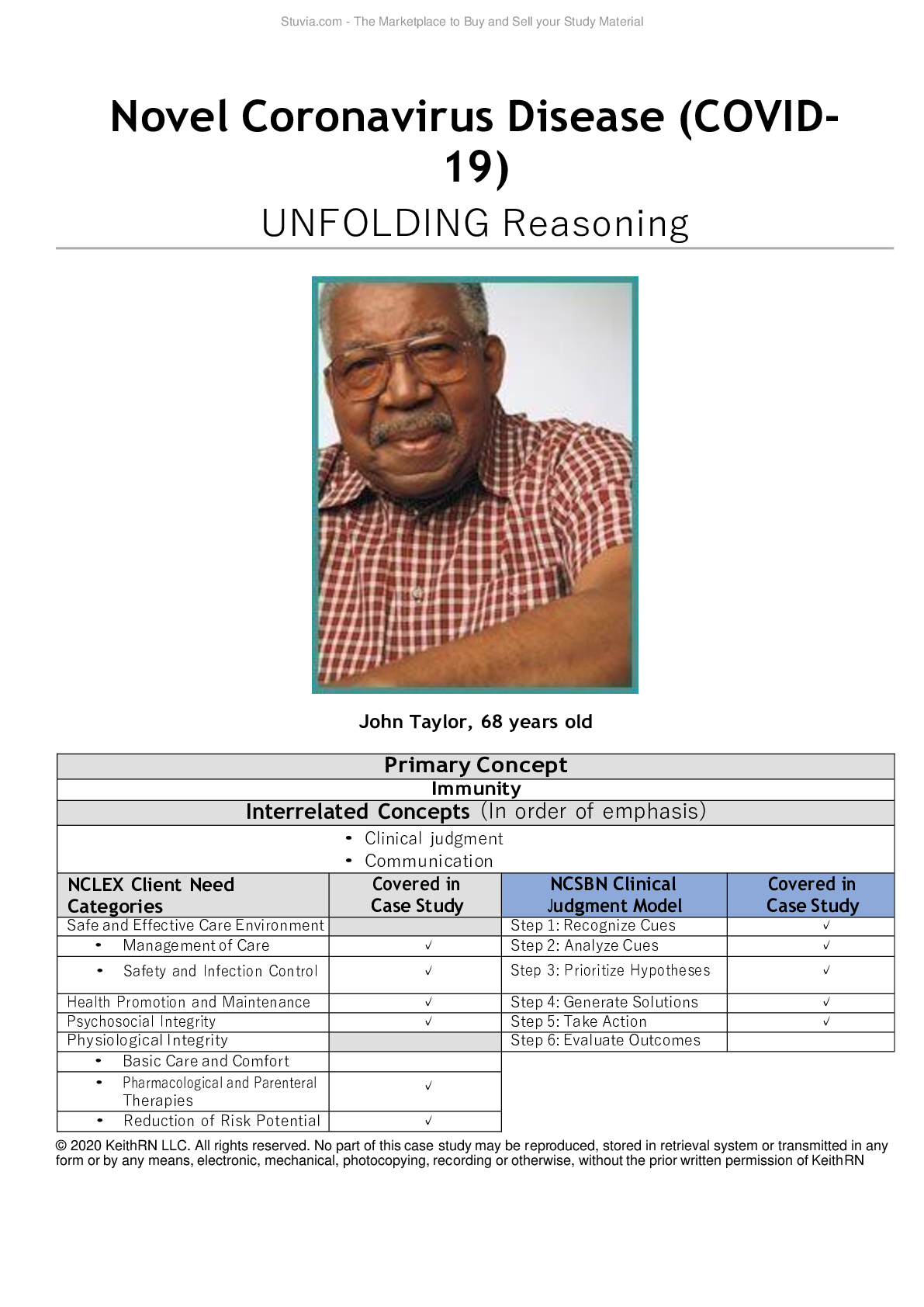*NURSING > CASE STUDY > COVID-19 Case Study | John Taylor is a 68-year-old African-American male with a history of type II d (All)
COVID-19 Case Study | John Taylor is a 68-year-old African-American male with a history of type II diabetes and hypertension who came to emergency department (ED).
Document Content and Description Below
COVID-19 Case Study: Present Problem: John Taylor is a 68-year-old African-American male with a history of type II diabetes and hypertension who came to emergency department (ED) triage window bec... ause he felt crummy; complaining of a headache, runny nose, feeling weak, “achy all over” and hot to the touch and sweaty the past two days. When he woke up this morning, he was no longer hot but began to develop a persistent “nagging cough” that continued to worsen throughout the day. He has difficulty “catching his breath” when he gets up to go the bathroom. John is visibly anxious and asks, “Do I have that killer virus that I hear about on the news?” Personal/Social History: John lives in a large metropolitan area that has had over three thousand confirmed cases of COVID-19. He has been married to Maxine, his wife of 45 years and is retired police officer and active in his local church. 1. What data from the histories are RELEVANT and must be NOTICED as clinically significant by the nurse? • • 2. What additional clarifying questions does the triage nurse need to ask John to determine if his cluster of physical symptoms are consistent with COVID-19? • Has your wife, or anyone in your household have similar symptoms to you, that presented before or maybe even after your symptoms presented? • Have you or your wife come into contact with anyone that you know has tested positive for COVID-19? • Have you or anyone you have come into contact with taken any international travel? (China, Italy, etc). where high rates of COVID-19 has presented? 3. What type of isolation precautions does the nurse need to implement if COVID-19 is suspected? What specific measures must be implemented to prevent transmission? Type of Isolation: Implementation Components: • Universal precautions should always be taken but contact isolation should be followed • 4. What are the six steps in the chain of infection? Apply what is known about COVID-19 to each step. Six Steps: Coronavirus COVID-19: 1. The infectious agent 2. Reservoir 3. Portal of Exit 4. Mode of Transmission 5. Portal of Entry 6. Susceptible Host 5. Is this patient a susceptible host? What step in the chain of infection does proper isolation precautions impact? Why? Patient Care Begins: John is brought back to a room. As the nurse responsible for his care, you collect the following clinical data: 1. What VS data are RELEVANT and must be NOTICED as clinically significant by the nurse? RELEVANT VS Data: Clinical Significance: • 2. What body system(s) will you assess most thoroughly performing a FOCUSED assessment based on the primary/priority problem? PRIORITY Body System: PRIORITY Nursing Assessments: Current FOCUSED Nursing Assessment: GENERAL SURVEY: NEUROLOGICAL: HEENT: . RESPIRATORY: CARDIAC: ABDOMEN: INTEGUMENTARY: 3. What assessment data is RELEVANT and must be NOTICED as clinically significant by the nurse? RELEVANT Assessment Data: Clinical Significance: • 4. Interpreting the clinical data collected, what problems are possible? Which problem is the PRIORITY? Why? Anxiety leading to elevated blood pressure when patient already suffers from hypertension putting him at risk for stroke or a hypertensive crisis. His elevated temperature, nonproductive cough, and his inability to “catch his breath” can be related to COVID-19 and confirmed with nasal or throat swab. Of course, the COVID-19 would be the priority problem at this point and time because it can cause larger respiratory issues possibly leading to intubation of the patient if severe enough. 5. What nursing priority(ies) and goal will guide how the nurse RESPONDS to formulate a plan of care? Nursing PRIORITY: Patency of Airway, effective breathing and circulation GOAL of Care: To maintain adequate oxygenation to tissues. Nursing Interventions: Rationale: Expected Outcome: • Caring and the “Art” of Nursing 1. What is the patient likely experiencing/feeling right now in this situation? What can you do to engage yourself with this patient’s experience, and show that they matter to you as a person? What Patient is Experiencing: How to Engage: References: Johnson, M., Maas, M.L., Moorhead, S., Swanson, E. (2018). Nursing outcomes classification (NOC). El Sevier: St. Louis, MO. [Show More]
Last updated: 1 year ago
Preview 1 out of 6 pages

Buy this document to get the full access instantly
Instant Download Access after purchase
Buy NowInstant download
We Accept:

Reviews( 0 )
$9.00
Can't find what you want? Try our AI powered Search
Document information
Connected school, study & course
About the document
Uploaded On
Mar 08, 2021
Number of pages
6
Written in
Additional information
This document has been written for:
Uploaded
Mar 08, 2021
Downloads
0
Views
187
















 COVID-19 Unfolding Case Study Part 1.png)





